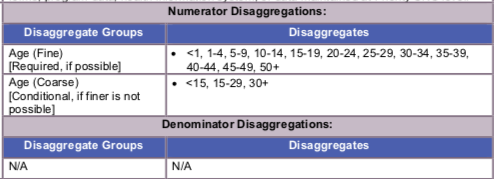(VMMC_CIRC_NAT) Number of males circumcised during the reporting period according to national standards
Export Indicator
There is compelling evidence that male circumcision provided by well-trained health professionals in properly equipped settings is safe and can reduce the risk of heterosexually acquired HIV infection in men by approximately 60%. WHO/UNAIDS recommendations emphasize that male circumcision should be considered an efficacious intervention for HIV prevention in countries and regions in which heterosexual activity plays a significant role in HIV transmission.
This indicator is harmonized with GAM indicator “Number of male circumcisions performed according to national standards during the past 12 months.”
Males should be provided with circumcision as part of the VMMC for HIV prevention program and in accordance with the WHO/UNAIDS/Jhpiego Manual for Male Circumcision Under Local Anesthesia, or other WHO normative guidance (in the case of device-based VMMC), and per national standards by funded programs/sites in the reporting period meet the definition for the numerator. Males who are provided with circumcision using a medical device by funded programs/sites in the reporting period also meet the definition for the numerator as long as the device used is recognized or pre- qualified by WHO.
Number of males circumcised during the reporting period according to national standards
N/A
How to collect:
This indicator measures the progress in scaling up male circumcision services and should be calculated by counting male clients documented as having received VMMC within the reporting period from VMMC Registries or clients’ medical records maintained by programs at Priority SNU level. Data should be collected from health facility recording and reporting forms, program data, health information system, or data maintained at Priority SNU level.
Reporting level: National and Sub-national: Data should be entered for all SNUs, regardless of PEPFAR- funded support for these geographical areas; so that the total of the sub-national number should equal the total number of national number.
Reporting frequency: Annually

Indicator changes (MER 2.0 v2.3 to v2.4): None
Data entered by: This data should be entered in DATIM by the USG country team.
Guiding narrative questions:
- Narratives should include information on how national and subnational totals have been derived for both results and targets.
- What barriers are there to further scaling up VMMC services in the country?